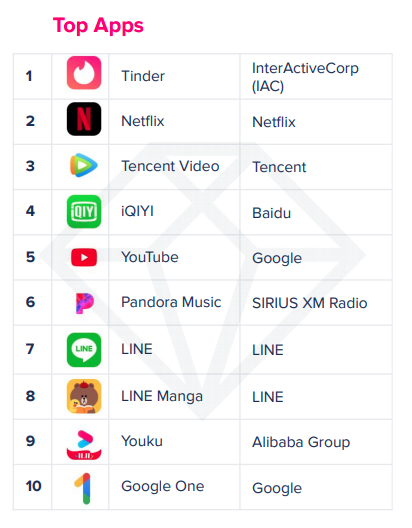This surprising app made the most money in 2019

Can money buy love? The jury is out, but according to a new report, the ability to buy more swipes on Tinder comes pretty close.
Related story: Sydney woman charges $1,500 per month to get you Tinder dates
Related story: Tinder's most right-swiped jobs from around the world
Related story: Study finds Grindr, OKCupid and Tinder sharing sensitive data (updated)
Dating app Tinder has been named the non-gaming mobile app with the highest worldwide consumer spend in 2019, followed by Netflix and Tencent Video in the latest App Annie State of Mobile report.
In 2019, global consumers spent more than US$2.2 billion on dating apps - more than double what was spent in 2017.

Additionally, Tinder was the second-highest non-gaming app for consumer spending over the last decade, as love-seekers purchased Tinder Plus subscriptions.
Today, Tinder marks 2 billion views a day and 30 billion matches, producing 1 million dates a week.
How does Tinder make money?
Tinder can be used for free - users log on, upload images and a bio and begin swiping. If two users find each other interesting and swipe right on each other, they’ll receive a notification and can begin chatting. If only one user swipes right, the two won’t be paired.
However, there are limits to the free service. Swiped left too quickly on a potential date? That hunk was lost in the void until Tinder Plus, introduced in 2015, began allowing desperate users to undo that hasty swipe.
And if you were searching for a foreign love, Tinder Plus allows users to swipe for overseas matches.
Additionally, under the free Tinder, users have three ‘Super Likes’ a day. A Super Like means that a prospective date knows of your interest without having to swipe first.
But if you really like a lot of people, Tinder Plus allows you to dole out five Super Likes a day.
Tinder Plus costs between $7.08 - $14 a month in Australia, although charged less in developing countries.
Tinder launched a higher tier in 2017, Tinder Gold. That costs $10-$21.99 a month and allows users to see who liked them.
In comparison, popular dating app Bumble offers Bumble Boost which is $5.58-$13.99 a week which allows users to re-match with expired connections and see who has liked you.
Users can also pay for extra swipes and Super Likes on a pay-per-use basis.
Tinder averaged 5.7 million subscribers in the September 2019 quarter, up 1.6 million over the year, building Tinder owner Match Group’s total revenue over the year to US$541 million.
Tinder challengers

Tinder has battled accusations that it facilitates sexual harassment, with research from Federation University finding that harassment on the platform came in three main forms.
Users who harassed others generally used it to sexually coerce ‘dates’, to meet their own sexual needs without considering others’, or used the app to take advantage of the anonymity on the platform.
Tinder challenger Bumble launched in late 2014 and was marketed as the women-friendly alternative. On Bumble, conversations can’t begin unless the woman initiates it, and Bumble was also notable for its LGBTIQ+ facilities.
And while Tinder has the highest spend, growth in Bumble spending over 2018-19 has outpaced that of Tinder.

But it’s still significantly behind Chinese dating app Tantan, which has seen consumer spend grow by around 7,000 per cent. That app also features quizzes and games.
And spending growth on Tinder and Bumble is also below Hily, which stands for ‘Hey, I Like You’.
That app has seen spending growth of more than 1,100 per cent. Hily’s difference is in its artificial intelligence, which suggests users for each other based on shared interests and values.
Make your money work with Yahoo Finance’s daily newsletter. Sign up here and stay on top of the latest money, news and tech news.



